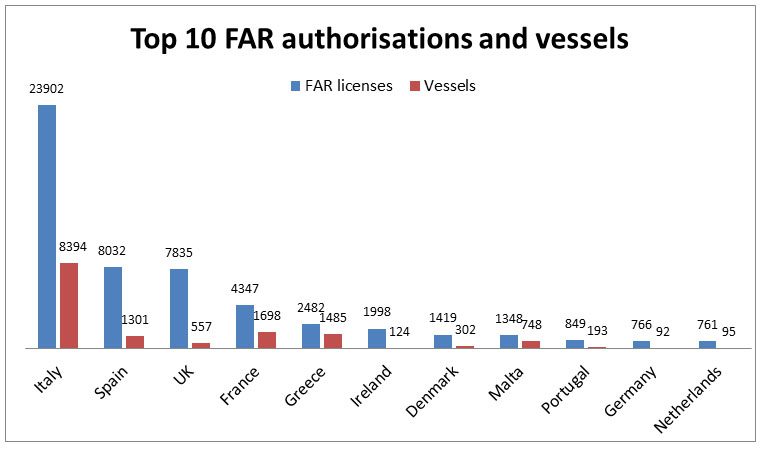NGOs launch fishing transparency website identifying 15,264 EU vessels authorised to fish outside the EU
Press Release Date: July 29, 2015
Location: Madrid
Contact:
Marta Madina | email: mmadina@oceana.org | tel.: Marta Madina
29th July 2015: Today, the Environmental Justice Foundation (EJF), Oceana and WWF heralded a new era of fisheries transparency with the launch of an online database detailing 15,264 EU vessels authorised to fish outside EU waters between 2010 and 2014. The figures have been made public by the NGOs for the first time after an access-to-information request to the European Commission.
María José Cornax, Fisheries Campaign Director of Oceana, has stressed the importance of this disclosure: “Transparency is a key element for eradicating illegal fishing and ensuring sustainable fisheries. This is especially relevant for European vessels that have been authorised to operate in third countries and distant waters. To ensure sustainability on a global scale, EU fishing vessels should adhere to the same social and environmental standards regardless of where or how they fish.”
The data provided by the European Commission is presented in an accessible online search engine whofishesfar.org where users can search by vessel, flag state, year and type of agreement under the EU’s Fishing Authorisation Regulation (FAR). This is the first time the information has been made public: it was previously unknown how many vessels were authorised to fish outside the EU, what they were called, and where and when they were authorised to fish.
Eszter Hidas, EU Policy Officer for WWF’s Illegal Fishing programme, stated: “The database is an important step towards transparency. But more needs to be done. First, the Commission should make a clear commitment to regularly release this information. Second, this information should include an analysis of the fishing activity in order to identify who is fishing, what, where and with which capacity. And, third, this should include private partnership agreements between EU operators and third countries. This will give us a complete overview of the global impact of the EU’s fishing activity.”
The database includes vessels authorised to fish under official European fisheries partnership agreements, in third country waters, high seas and in Regional Fisheries Mangement Organisations. However, it does not include the so called ‘private agreements’ between vessel owners and coastal states, which allow the owners’ vessels to fish in the state’s waters, as these are not reported to the European Commission by EU member states. Campaigners are calling for member states to increase transparency and accountability for such private agreements when the FAR is updated this fall.
Notes to the editor
- The Fishing Authorisation Regulation[1] governs the European Union’s large fishing fleet when operating outside EU waters by providing them with fishing authorisations. It also provides authorisations for non-EU countries’ vessels, such as Norway, Iceland and Faroe Islands, to fish in EU waters.
- The access to information request concerned all FAR authorisations granted from 2010 to 2014. Data provided by the European Commission also include some authorisations from 2006 and up to 2020, however those data from before 2010 or after 2014 are incomplete.
- whofishesfar.org includes 15,264 EU vessels authorised to operate in third countries’ waters or in the high seas between 2010 and 2014. It also includes 978 non-EU vessels flagged to Faroe Islands, Norway, Venezuela and Seychelles that were operating in EU waters. This number differs considerably from the 2007 figure of 718 vessels given as the size of EU’s distant fleet[2]. However, the 2007 figure looked at vessels that operated more than 90% of the time outside EU waters.
- There is little transparency and control under the current FAR Regulation for private agreements, which are between EU companies and certain non-EU coastal states that grant them access to fish resources in their waters. The Commission reports that no EU-wide database of information exists for these private agreements since member states are only required to report to the European Commission the names of the vessels operating under such agreements..
- When the FAR is revised in 2015 there will be an opportunity to increase transparency and accountability on private agreements between EU companies and third countries. This will help to ensure that these authorisations comply with EU fisheries laws and respect labour laws, and to reassure the EU operator that the authorisation they have bought is valid.
- The graph below shows that for the period 2006 to 2020, the top 10 EU member states (in terms of number of authorisations) issued more than 53,000 FAR authorisations. These authorise EU vessels to operate in the Atlantic, Indian and Pacific Oceans, as well as under regional fisheries management organisations, or access agreements for Norwegian or Faroese waters. Most of Italy’s 23,902 authorisations were for vessels targeting swordfish and tuna species under the International Convention for the Conservation of Atlantic Tuna (ICCAT).
- The Environmental Justice Foundation (EJF), Oceana and WWF are working together to secure the harmonised and effective implementation of the EU Regulation to end illegal, unreported and unregulated (IUU) fishing.

[2] Study on the European External Fleet Contract FISH/2006/02 Final Report, January 2008 http://ec.europa.eu/fisheries/documentation/studies/study_external_fleet/external_fleet_2008_en.pdf

